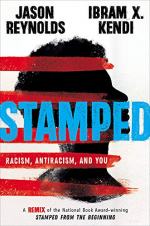|
This section contains 508 words (approx. 2 pages at 400 words per page) |

|
Stamped: Racism, Antiracism, and You Summary & Study Guide Description
Stamped: Racism, Antiracism, and You Summary & Study Guide includes comprehensive information and analysis to help you understand the book. This study guide contains the following sections:
This detailed literature summary also contains Topics for Discussion on Stamped: Racism, Antiracism, and You by Jason Reynolds.
The following version of this book was used to create this guide: Reynolds, Jason and Ibram X. Kendi. Stamped: Racism, Antiracism, and You. Little, Brown and Company, 2020.
Jason Reynolds' Stamped: Racism, Antiracism, and You is a concise, honest, and accessible "not history history book" meant to give readers of all ages a timeline of how racist ideas were born, spread, and engrained in American society (3). Adapted from Ibram X. Kendi's Stamped from the Beginning: The Definitive History of Racist Ideas in America, Reynolds takes his reader on a conversational and fast-paced journey from 1415 to present day, tracking the development of racist ideas. Reynolds' journey begins in Portugal in 1415, where a commander in the army was the first person to "write about and defend Black human ownership... [which] began the recorded history of anti-Black racist ideas" (7). Moving seemingly unchanged through time and space, the same ideas birthed in Portugal in 1415 catapulted themselves to the American colonies in the 1600s. From the early days of colonial America, through the Revolutionary War, up until the Civil War, the conversation about racial equality stayed largely the same. The combined forces of the church and the economic system kept slavery alive and growing, based largely on the false narrative that "Africans are savages" (50).
The end of slavery in America did nothing to end the racist ideas circulating in America. Those were still embedded in instructions such as schools, churches, and laws, and thus kept Black Americas subjugated under the same ideologies that defended slavery. From the work of intellectuals of the past such as William Lloyd Garrison, to the present day Black Lives Matter movement, the ideas of inferiority and privilege have been debated, expanded, and swept under the rug, but have never truly gone away. Reynolds takes the time in this book to not only analyze the thoughts and actions of those propagating racist ideas; he also offers his reader an analysis of the many ways Black writers, activists, and artists have advocated on behalf of racial equality, such as W.E.B. Du Bois, Malcolm X, and Angela Davis.
Reynolds organizes his discussion on racial inequality around three central terms: segregationist, assimilationist, and antiracist. He provides both formal definitions and colloquial definitions for these terms; a segregationist is "a hater," an assimilationist is a "coward," and an antiracist is "someone who truly loves" (247). These terms are used throughout the text to classify people, ideas, actions, policies, and eventually even the reader. After providing examples of how countless historical figures have shown signs of one or more of these categorizations, Reynolds invites his readers to judge themselves. With a mix of lighthearted and serious tones, a clear dedication to not be just another history book, and the ability to succinctly summarize historical data, Reynolds offers his readers opportunity to choose "[their] seat - the right seat - at the table" (3). Though written with a young adult audience in mind, this book allows readers of all ages to engage in a difficult, vulnerable, and necessary conversation about racial inequality in America.
Read more from the Study Guide
|
This section contains 508 words (approx. 2 pages at 400 words per page) |

|



